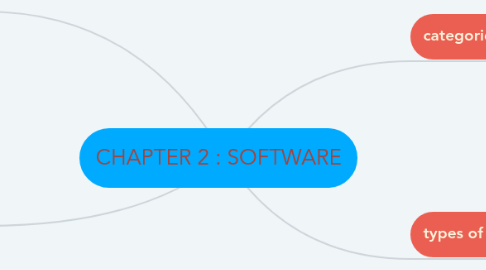
1. definition
1.1. consists of a series of related instructions, organized for a common purpose, that tells the computer what task to perform and how to perform them.
2. applications
2.1. web browser
2.1.1. allow users to access and interact with software from any computer or device that is connected to the internet
2.1.2. internet explorer , Mozilla Firefox
2.2. word processing
2.2.1. allow users to create and manipulate documents
2.2.2. Microsoft Office Word , Kword
2.3. spreadsheet
2.3.1. allow users to organize data in rows and columns and perform calculations
2.3.2. Microsoft Office Excel, Kcells
2.4. database
2.4.1. allow users to create, access and manage a database
2.4.2. Microsoft Office Access, OpenOffice.org Base
2.5. presentation
2.5.1. alllow users to create visual aids for presentation to communicate ideas, messages and other information.
2.5.2. Microsoft Office PowerPoint, OpenOffice.org impress
3. categories
3.1. open source software
3.1.1. created by unpaid volunteers, begin to gain wide acceptance among computer users,
3.1.2. freely
3.2. proprietary
3.2.1. privately owned and limited to a specific vendor or computer model
3.2.2. license/paid
4. types of system software
4.1. operating system
4.1.1. is a set of programs containing instructions that work together to coordinate all the activities among computer hardware resources
4.1.2. types
4.1.2.1. stand alone Operating System
4.1.2.1.1. complete operating system that works on a desktop computer, notebook computer, or mobile computing device
4.1.2.1.2. proprietary : windows
4.1.2.1.3. open source : Unix , Linux
4.1.2.2. server Operating System
4.1.2.2.1. designed to support a network
4.1.2.2.2. proprietary : windows server 2008
4.1.2.2.3. open source : Unix , Linux
4.1.2.3. embedded/ mobile Operating System
4.1.2.3.1. an embedded operating system resides on a ROM chip on a mobile device or consumer electronic device
4.1.2.3.2. proprietary : windows embedded
4.1.2.3.3. open source : Google Android, Embedded Linux
4.1.3. functions
4.1.3.1. start and shutdown a computer
4.1.3.1.1. the process of starting and restarting a computer is calling booting
4.1.3.1.2. types
4.1.3.2. provide a user interface
4.1.3.2.1. user interface controls how you enter data and instructions and how information is displayed on the screen
4.1.3.2.2. types
4.1.3.3. manage program
4.1.3.3.1. an OS manages multiple programs and processes while you use the computer
4.1.3.4. manage memory
4.1.3.4.1. OS allocates data and instructions to memory while they are being processed, monitors the content of memory and release from memory when the processor no longer required them
4.1.3.5. coordinate task
4.1.3.5.1. the OS determines the order in which tasks are processed
4.1.3.6. configure device
4.1.3.6.1. short for device driver : a small program that tells the OS how to communicate with a specific device
4.1.3.6.2. driver : is a small program that tells the operating system how to communicate with a specific device
4.1.3.6.3. plug and play
4.1.3.7. establish an internet connection
4.1.3.7.1. OS typically provide a means to establish internet connection
4.1.3.8. monitor performance
4.1.3.8.1. program that assesses and reports information about various computer resources and devices
4.1.3.9. provide file managements and other utilities
4.1.3.9.1. managing files
4.1.3.9.2. searching files
4.1.3.9.3. viewing imanges
4.1.3.9.4. securing a computer
4.1.3.9.5. uninstalling programs
4.1.3.9.6. cleaning disks
4.1.3.9.7. defragmenting disks
4.1.3.9.8. diagnosing problems
4.1.3.9.9. backing up files and disks
4.1.3.9.10. setting up screensavers
4.1.3.10. automatically update
4.1.3.10.1. automatically provides updates to the program
4.1.3.11. control a network
4.1.3.11.1. some operating systems are designed to work with a server on a network
4.1.3.12. administer security
4.2. utility program
4.2.1. is a type of system software that allows a user to perform maintenance-type task
4.2.2. types
4.2.2.1. file manager
4.2.2.1.1. provide routine file management tasks
4.2.2.2. disk cleanup
4.2.2.2.1. searches and removes unnecessary file
4.2.2.3. compression tools
4.2.2.3.1. shrinks the size of a file
4.2.2.4. anti-virus program
4.2.2.4.1. protect a computer against viruses by identifying and removing any computer viruses found in memory, on storage media or incoming files
4.2.2.5. spyware remover
4.2.2.5.1. detects and deletes spyware
4.2.2.6. disk defragmenter
4.2.2.6.1. reorganizes the files and unused space on a computer hard disk so that the OS accesses data more quickly
4.2.2.7. backup and restrore
4.2.2.7.1. backup : allow user to copy files to another storage medium in case of damage or lost
4.2.2.7.2. restore : reverses process and returns backed up file to their original form

